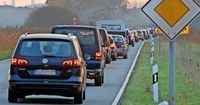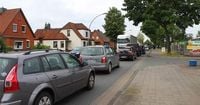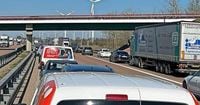On August 21, 2025, drivers across northern and central Germany faced an all-too-familiar summer headache: widespread traffic jams and sluggish commutes, stretching from the coastal city of Lübeck down to Remscheid in North Rhine-Westphalia. According to regional reports compiled by local newspapers and bolstered by real-time navigation data, the day was marked by significant slowdowns on highways, federal roads, and even key city streets, as a combination of construction projects, accidents, and sheer volume brought travel to a crawl in many areas.
In Celle and its surrounding region, the Celle Zeitung reported that traffic was notably slower than usual on several crucial arteries. The Bundesstraße 3 (B3), leading south toward Hannover and north toward Soltau, saw heavy congestion, as did the B214 in both Braunschweig and Schwarmstedt directions. The B191 toward Uelzen was also affected, while the Wilhelm-Heinichen-Ring in Celle itself became a particular bottleneck due to ongoing construction work. "Please take care and show consideration for other road users!" the paper reminded its readers, echoing a sentiment repeated in traffic updates across the region.
Further west, the city and district of Nienburg experienced their own share of traffic woes. As detailed by Die Harke, highways A2, A37, A7, A27, and A1 were all plagued by slow-moving vehicles, compounded by backups on a slew of federal roads: B6, B215, B214, B482, B62, B239, B51, B442, and B441. The cause? A mixture of new construction sites and unexpected accidents, leading to what the paper called "noticeably slower progress than usual." Like their counterparts in Celle, Nienburg’s traffic reporters sourced their data from TomTom’s extensive network of GPS-enabled devices, promising updates every five minutes to keep drivers informed as conditions evolved.
Heading north to Lübeck and the broader Schleswig-Holstein region, the Lübecker Nachrichten painted a picture of persistent congestion, especially on the A1 highway. This crucial route, which snakes through Stormarn, skirts Lübeck, and continues through Ostholstein to Fehmarn, is a lifeline for tourists heading to the Baltic coast. As the LN noted, "the A1 is frequently congested during tourist peak times, especially on the stretch through Stormarn, past Lübeck, through Ostholstein to Fehmarn." Other highways—A20 and A226—along with federal roads B75, B207, and B104, were also affected. The ADAC, Germany’s largest automobile club, confirmed that the A1 and A7 are among the most jam-prone stretches in the north, particularly during the summer holiday rush.
In the rural yet vital region of Ostprignitz-Ruppin, the Märkische Allgemeine Zeitung reported that cities like Neuruppin, Wittstock/Dosse, Kyritz, and Fehrbellin were not immune to the day’s traffic troubles. Highways A14, A19, and A24 all suffered from slowdowns, with specific sections—such as the A24 from Linumer Bruch through Fehrbellin, Neuruppin, Wittstock, and Pritzwalk to Putlitz—highlighted as congestion hotspots. Federal roads B5, B102, B103, B107, B122, B167, B189, and B195 also featured prominently in the day’s list of problem areas. The paper offered a detailed breakdown of the worst-affected stretches, providing a roadmap of frustration for anyone traveling that day.
Meanwhile, in Remscheid and its neighboring towns of Wermelskirchen, Solingen, and Wuppertal, the Remscheider General-Anzeiger described a traffic situation that was, if anything, even more daunting. The A1 highway section between Köln and Dortmund stood out, with the paper noting that it experiences "almost 6500 hours of traffic jams," making it one of the top congestion hotspots in the entire country. The A46, connecting Düsseldorf and Wuppertal, was identified as the sixth most congested route in North Rhine-Westphalia. Major regional roads—B229, B237, B51/B51n, L74, L81, L101, L418, and B483—were all highlighted as essential yet frequently clogged arteries. The ongoing reconstruction of the Wuppertal-Nord interchange was singled out as a "mammoth project" that will shape the region’s traffic landscape for the next decade.
Gifhorn and its surroundings, as reported by Aller-Zeitung and Wolfsburger Allgemeine Zeitung, were similarly affected. Highways A2 and A39, along with federal roads B188, B4, B214, B248, and the K114, all saw slower-than-usual traffic. The recurring theme across all these regions was clear: a combination of scheduled construction, routine maintenance, and the unpredictable nature of summer travel had conspired to create a perfect storm of gridlock.
What ties these regional reports together is a shared reliance on TomTom’s sophisticated traffic monitoring system. Each newspaper cited TomTom as their primary data source, with the company drawing on "GPS coordinates from several million devices," as well as "automatic data from around 80 million mobile devices, several million official road sensors, and manually maintained information." This vast pool of data, updated every five minutes, allows for a near real-time snapshot of traffic conditions. Other navigation providers, such as Google Maps, Apple Maps, and Garmin, also contribute to the ecosystem of traffic information, but TomTom’s reach and granularity were repeatedly emphasized in the day’s reporting.
The result for drivers, however, was the same regardless of data source: patience was in short supply as vehicles inched along highways and detoured around construction zones. The newspapers in each city and region urged readers to show courtesy and caution. As Lübecker Nachrichten put it, "Please always show consideration for other road users." It was a refrain echoed from Celle to Remscheid, a reminder that, amid the frustration of gridlock, a little patience can go a long way.
Of course, these traffic woes are not new. Germany’s dense network of Autobahns and Bundesstraßen is both a source of national pride and a perennial challenge. The ADAC’s annual rankings of the country’s most congested routes—like the A1 and A46—are closely watched by commuters and policymakers alike. Major infrastructure projects, such as the Wuppertal-Nord interchange overhaul, promise long-term improvements but often bring short-term headaches. Meanwhile, the summer holiday season reliably turns certain stretches, particularly those leading to the coast or popular tourist destinations, into parking lots.
For many, the hope is that ongoing investments in road maintenance, smarter traffic management systems, and perhaps even a cultural shift toward public transport or carpooling might eventually ease the pain. Until then, though, August 21, 2025, will be remembered as another day when drivers across Germany were united by a single, slow-moving experience: the long, hot wait in traffic.


